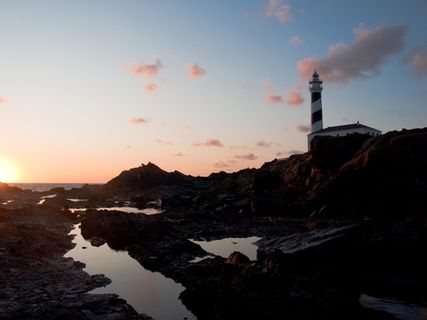Menorca Top Sightseeing
Cap de Favàritx
Viewpoint and Lighthouse | Maó - MahónThis solitary cape, battered by storms from the north, is one of the island's oldest places from the geological standpoint. Cap de Favàritx is a rocky point formed by black slate and flanked by bays on both sides. The coast is characterised by low, black and grey slate cliffs that are some of the Balearic's oldest lands from a geological point of view. The interior is crisscrossed by fine springs that run along the surface until encountering a land mass and disappearing underground again. Fossils of the first beings to inhabit the site can be seen in the slate: crustaceans and miniscule marine creatures from thousands of years ago. The zone near the lighthouse is battered by winds, especially the north wind, and waves crash over the coastal barrier made up of a pebble beach next to the lighthouse, flooding an esplanade and forming an off-white surface known as 'La Salina', or salt flat, when dry. Two different types of material and long veins of bright ochre oxide can be seen in the rock to the left of the lighthouse. Legend has it that on nights when the moon is full, those who walk alongside these magic pools will receive the beneficial effects of the moon and seawater: strength, energy and fertility. In addition to the lighthouse, the road to Son Camamil·la leads to two unusual and striking, long, open coves: Cala Presili and Cala Tortuga, the former with a fine, very dark sandy beach and the latter with a smaller, yet fetching gravel beach. To get to Cap de Favàritx, go down the Mahon-Fornells road from Mahon around 8 kilometres and follow the turn-off to the right. The lighthouse at Cap de Favàritx, which dates back to 1922, is 6 kilometres down the road.
Travelers reviews
Number of user reviews:23.9Download your Menorca guide!
Favorites
-
- You have currently no favorites. Click on to start planning your trip.







Road closed half september
Luogo lunare: bellissimo.